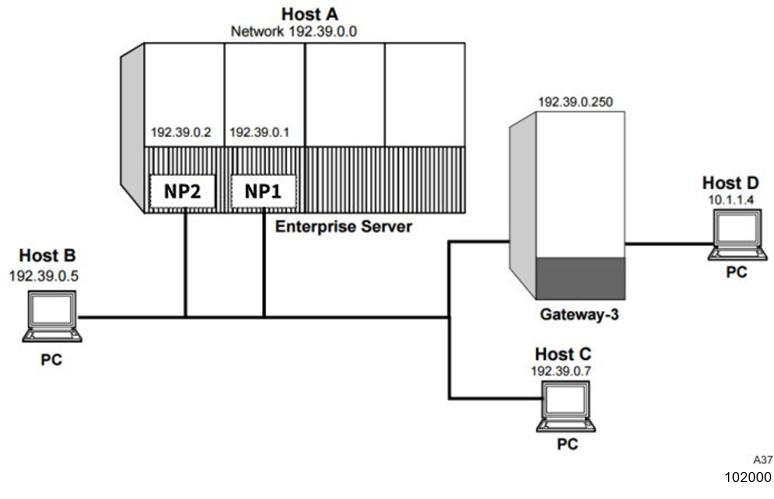| Note: | This feature is supported only in the IPv4 operating mode. |
When several NPs are available to reach the same remote node and the MYIPADDRESS system attribute is not specified, the local IP address chosen is based on the memory utilization of the NPs. When a connection is initiated and the MYIPADDRESS attribute is not specified, the NPP with the least utilization (including BNA and TCP traffic) is used for the duration of the connection.
If specific NPs are required for communication to certain IP addresses, you can use the IP Address List (IPADDRESSLIST) attribute to specify these IP addresses. This is a connection attribute that is set in the IP connection definition. This attribute will only be used when connections are initiated at the enterprise server. Passive connections will use the IP address specified with the incoming connection as the source IP address on all outgoing frames, regardless of the setting of the IPADDRESSLIST attribute. However, the path (route) of the outgoing frames is determined by the IPADDRESSLIST attribute.
This functionality is the same for NPs that are shared for BNA and TCP/IP traffic and does not depend on NP type.
Specifying the IPADDRESS Value for Local and Remote Addresses
You can use the IPADDRESSLIST attribute to specify both local IP Addresses (on the same LAN segment), and remote IP Addresses (must traverse a router). If you are configuring a local IP Address, specify the destination IP Address for this attribute. If you are configuring a remote IP Address, specify the IP Address of the next-hop router for this attribute.
Example
For example, if Host A has two NPs with the following IP addresses:
192.39.0.1 (NP1)
192.39.0.2 (NPP2)
and you want Host A to use NP1 for communicating with two local hosts, Host B (192.39.0.5) or Host C (192.39.0.7), the IP connections for NP1 should be set as follows:
IPADDRESSLIST=(192.39.0.5, 192.39.0.7)
If you want Host A to use NP2 for communicating with Host D (10.1.1.4), which is reached through a router (192.39.0.250), the IP connections for NP2 should be set to specify the address of the next-hop router as follows:
IPADDRESSLIST=(192.39.0.250)
All connections initiated at Host A will use NP1 to communicate with Host B and Host C, and NP2 to communicate with Host D. However, if Host A receives a connection request from Host B or Host C for IP address 192.39.0.2, NP2 will be used for the duration of this connection. (Specifying IPADDRESSLIST Values shows this network).


